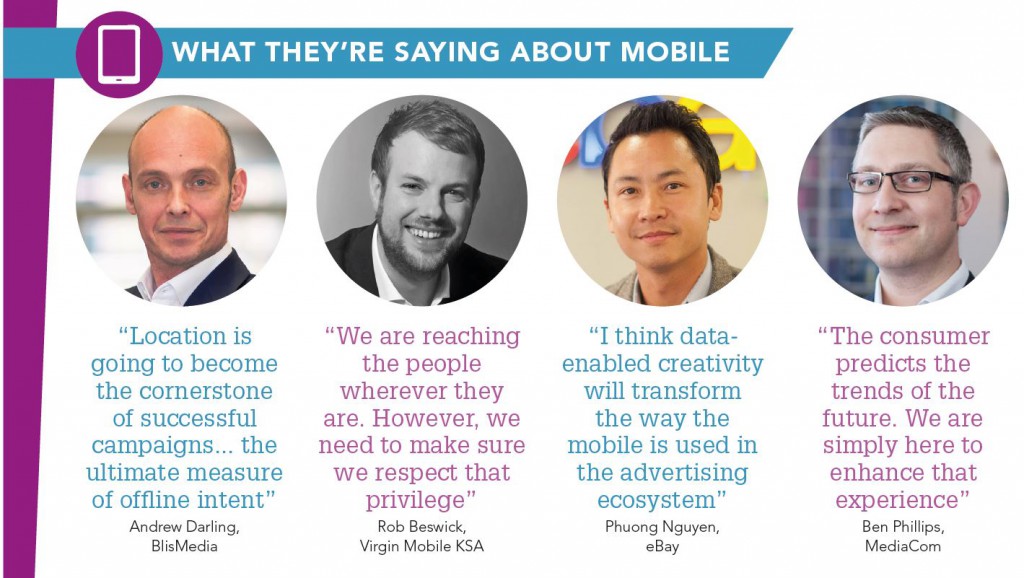Smartphones are a treasure trove for marketers, but the old rules of relevance still apply, writes Anna Dobbie.
Over the past 12 months, mobile has exploded. To quote just a few of the incredible statistics, 150% of Swedish people now own a smart device, and mobile web use has surpassed that of desktop in the US. The number of mobile video viewers in the UK alone is set to increase 29% by 2016 to more than 22 million, while in the US it will hit 117 million, according to eMarketer.
This explosion has opened up new methods of engagement, monetisation and personalisation to marketers, with location marketing a hot topic.
The combination of ‘what’, ‘where’, ‘when’ and ‘why’ has transformed marketers’ ability to know what individual customers want and need, and what they do in their everyday lives, allowing effective, contemporary, one-to-one outreach.
New location-driven technologies and analytics gather behavioural knowledge to predict future trends which can be aggregated and put into CRM to develop personalised, compelling and relevant customer relationships.
For example, if a customer has put an item in their cart online but fails to check out, location targeting may issue them with a reminder when they are physically near a store about the product they have ummed and ahhed over.
Millennial Media’s EMEA managing director Zac Pinkham believes that location is the new cookie when it comes to targeting and engaging with audiences. “Contextual-based location targeting is one of the most popular methods of targeting across all industries,” he says, “due, in part, to mobile’s on-the-go unique characteristics.”
Programmatic mobile
Another area in mobile that Pinkham believes has evolved is programmatic, moving from being ‘the future’ to ‘the now’ of how digital media is traded.
“According to the IAB, programmatic share of mobile ad sales [in the UK] nearly doubled from 37% in 2013 to 64% in 2013 – with estimates that around 70-80% of all digital spend will be programmatic by 2018. With growth set to continue, there’s no denying just how crucial programmatic mobile is to the future of media trading.”
Millennial Media’s global research survey ‘What’s My Worth?’ showed that 48% of all consumers would be more likely to click on a mobile ad if it were somehow targeted to their interests. “Mobile is always with consumers and location data is relevant to a moment, acting as a bridge between the digital and the real worlds. It’s specific, reliable and encompasses where you are now and where you’re going later.”
Cookie comparison
However, location data specialist BlisMedia’s director of global marketing and communications Andrew Darling feels the cookie comparison is unfair as location is “about so much more than that”.
“For a long time, marketers thought location was when you were close to something and you could see if someone was near a shop. It’s all about proximity, but really you’ve got to look at location in a historical context,” he says.
“It’s not about where people are, but where they’ve been and it’s about using those insights to talk about where they’d like to go in the future.
“You can build up pretty good profiles around three- or four-week windows looking at where their device IDs turn up, whether it’s retail, in a shopping centre or hotel. You can increasingly use that to plot future behaviour.”
With people spending so much time on their smartphone domestically, even more than on laptops, Darling has found that brand engagement starts more at home: “This is great for a company like us because we track device IDs not only out in the open on 3G or 4G but also when they are at home on their own Wi-Fi IP addresses.”
He argues that a new era of personalisation is opening up as more and more data becomes available. “Not just first-party data, from people like us, but second-party data from Wi-Fi providers that are giving good demographic information and also location information, and then the myriad of third party data providers, which is allowing this really 360-degree picture,” he adds.
“Location is going to become the cornerstone of successful campaigns. In the same way that search and social became a measure of online intent over the past couple of years, location is going to be the ultimate measure of offline intent.”
Power of relevance
Virgin Mobile KSA deputy chief executive officer Rob Beswick feels that relevance is the main power of mobile advertising, and thus is the new ‘cookie’.
“Yes, we are reaching the people wherever they are. However, we need to make sure we respect that privilege by providing them with what they are looking for,” he says.
“That means promoting contextually relevant content to people using their location to highlight something that is close by and relevant to their interests. For us, it also means promoting personalised packages based on people’s usage behaviour,” he adds.
Beswick has noticed a 20% higher conversion from mobile ads versus desktop ones in Saudi Arabia: “We are always mobile-first and we want to play a genuine role in creating a platform to celebrate Saudi youth culture, and for young Saudi Arabians to inspire their peers and have conversations with us.
“It’s not about claiming any more, it’s about acting and that means being transparent, humble and sticking to your word”
“Given the importance of mobile in Saudi Arabia, it was a no-brainer for us to focus our marketing efforts there. Rather than traditional advertising spend, we have focused on smart digital communications using the digital channels that our target market use.”
Beswick feels that the future of mobile marketing lies in “offering advertising that people seek and want to subscribe to, rather than interruptive sales messaging that ruins the experience they are having at the time”.
“Brands need to focus on being where their customers are,” he adds. “Shouting at them there doesn’t work either. It’s not about claiming any more, it’s about acting and that means being transparent, humble and sticking to your word.”
“Mobile is driving our success,” concludes Beswick, “and is going to remain our top priority.”
Cookie-less world
eBay Advertising director Phuong Nguyen feels that mobile creates a “cookie-less world”, making it harder for most brands to understand how a user moves across devices. “It’s a major challenge that the industry needs to address,” he says, discussing how consumers like to browse in bite-size chunks on their mobile but purchase at a desktop.
“Data-enabled creativity will transform the way the mobile is used in the advertising ecosystem,” he adds.
Mobile is now included in the vast majority of media and creative plans, demonstrating its importance, according to MediaCom global head of mobile Ben Phillips.
“Measurement is everything,” he says. “Mobile as a tool for data collation and mining even within offline channels powers much of today’s advertising and supports a richer consumer experience.”
Phillips feels the industry is in the strongest position ever regarding mobile, pushing the responsibility on brands and advertisers to work with the handset capabilities and produce engaging content. “The consumer predicts the trends of the future,” he concludes. “We are simply here to enhance that experience.”









